Assessment of tilapia-freshwater prawn co-culture schemes in tanks and lake-based cages for increased farm production
| dc.contributor.author | Romana-Eguia, Maria Rowena R. | |
| dc.contributor.author | Rutaquio, Mildred P. | |
| dc.contributor.author | Gutierrez, Reylan C. | |
| dc.contributor.author | Salayo, Nerissa D. | |
| dc.date.accessioned | 2021-12-16T00:45:50Z | |
| dc.date.available | 2021-12-16T00:45:50Z | |
| dc.date.issued | 2021-12-08 | |
| dc.identifier.citation | Romana-Eguia, M. R. R., Rutaquio, M. P., Gutierrez, R. C., & Salayo, N. D. (2021). Assessment of tilapia-freshwater prawn co-culture schemes in tanks and lake-based cages for increased farm production. Sustainability, 13(24), 13574. | en |
| dc.identifier.issn | 2071-1050 | |
| dc.identifier.uri | http://hdl.handle.net/10862/6247 | |
| dc.description | Supplementary MaterialsThe following are available online at https://www.mdpi.com/article/10.3390/su132413574/s1, Figure S1: Growth (SGR) of the different freshwater aquatic species (Nile tilapia, red tilapias, prawns) reared for five months using the cage-in-tank monoculture and/or co-culture schemes, Figure S2: Survival of all the freshwater aquatic species reared in the cage-in-tank monoculture and/or co-culture systems, Figure S3: Specific growth rates of the tilapias and prawns reared in lake-based co-culture systems using different feeding schemes, Figure S4: Survival of the co-cultured tilapias and prawns in the lake-based cages using different feeding protocols, Figure S5: Results of plankton monitoring in the lake facility, wet season run, Figure S6: Results of plankton monitoring in the lake facility, dry season run | en |
| dc.description.abstract | The technical viability of tilapia (I-ExCEL strain Nile or red) and giant freshwater prawn (GFP) co-culture in cages-within-tanks was evaluated while appropriate feeding protocols for tilapia-GFP co-culture in cages in a eutrophic lake were determined. Specifically, production parameters in all test species grown for five months in tank co-culture (where only tilapias were fed) were compared, while the best feeding protocol from among the following treatments: (a) Tfed—fed tilapias; (b) GFPfed—fed prawns and (c) T-GFPfed—both species fed, were defined. I-ExCEL Nile tilapias grew faster in tank co-culture whether reared singly or otherwise. However, red tilapia-GFP tank co-culture gave the best results considering key production traits in all test species (red tilapia —2.52%/day specific growth rate or SGR, 83.3% survival; GFP—1.17%/day SGR, 72.85% survival). Lake-based co-culture was technically feasible at stocking densities of 12.5/m2 for tilapia and 2.4 to 4/m2 for prawns even when only tilapias were fed; prawns grew to desired marketable sizes by thriving mainly on detritus and natural food organisms in the lake. However, further refinements can still be made to optimise the co-culture schemes to make them more sustainable and provide artisanal fish farmers options in increasing farm yields through multi-species aquaculture. | en |
| dc.description.sponsorship | This research was funded entirely by the Southeast Asian Fisheries Development Center Aquaculture Department (SEAFDEC/AQD) under study code: FS-01-2020B. | en |
| dc.language.iso | en | en |
| dc.publisher | MDPI | en |
| dc.relation.uri | https://www.mdpi.com/2071-1050/13/24/13574/pdf | en |
| dc.rights | Attribution 4.0 International | * |
| dc.rights.uri | http://creativecommons.org/licenses/by/4.0/ | * |
| dc.subject | Nile and red tilapia | en |
| dc.subject | Giant freshwater prawn | en |
| dc.subject | Lake cages | en |
| dc.subject | Co-culture | en |
| dc.title | Assessment of tilapia-freshwater prawn co-culture schemes in tanks and lake-based cages for increased farm production | en |
| dc.type | Article | en |
| dc.identifier.doi | 10.3390/su132413574 | |
| dc.citation.volume | 13 | |
| dc.citation.issue | 24 | |
| dc.citation.spage | 13574 | |
| dc.citation.journalTitle | Sustainability | en |
| dc.subject.asfa | tilapia culture | en |
| dc.subject.asfa | prawn culture | en |
| dc.subject.asfa | freshwater aquaculture | en |
| dc.subject.asfa | aquaculture | en |
このアイテムのファイル
| ファイル | サイズ | フォーマット | 閲覧 |
|---|---|---|---|
|
このアイテムに関連するファイルは存在しません。 |
|||
このアイテムは次のコレクションに所属しています
-
Journal Articles [1258]
These papers were contributed by Department staff to various national and international journals.





